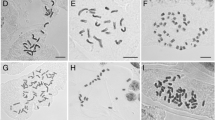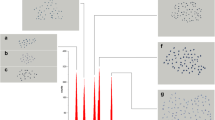Abstract
Ploidy can serve as an excellent diagnostic character and proxy for evolutionary and reproductive behaviour, particularly in taxonomically complicated apomictic genera. In Rubus, ploidy level has so far been established for 230 European species (ca 30% of the total), mainly from Western or central Europe. We present the first DNA ploidy data for 25 described species and 22 undescribed stable morphotypes from the Pannonian Basin and the northern Balkans (8 countries). We also review previously published ploidy data covering the entire bramble flora of the studied area (78 recognized species in total). The most common ploidy level is tetraploid, which is the only ploidy level in most series (e.g. Micantes, Rhamnifolii, Sylvatici). This likely reflects elevated sexuality and the higher probability of new species formation via hybridization in tetraploids compared to other ploidy levels. As in central Europe but unlike in other regions, we also recorded many triploid species, namely in ser. Discolores (19 species) and ser. Rubus (four species). The diversity of triploid Discolores in the region may be linked to the occurrence of diploid R. canescens, making the region a hot spot of triploid Rubus diversity. Six pentaploid and a single hexaploid species, all from sect. Corylifolii, were recorded. Ploidy proved to be a good diagnostic character for several species that are difficult to distinguish morphologically, confirming its importance in inventories of brambles. One of these species is described here as R. praecocifrons Király & Trávn.









Similar content being viewed by others
References
Alice L, Eriksson T, Eriksen B, Campbell C (2001) Hybridization and gene flow between distantly related species of Rubus (Rosaceae): evidence from nuclear ribosomal DNA internal transcribed spacer region. Syst Bot 26:769–778. https://doi.org/10.1043/0363-6445-26.4.769
Alice LA, Goldman DH, Macklin JA, Moore G (2015) Rubus. In: Flora of North America Editorial Committee (ed) Flora of North America North of Mexico, vol. 9. Oxford University Press, New York
Baltisberger M, Widmer A (2009) Chromosome numbers and karyotypes within the Ranunculus alpestris-group (Ranunculaceae). Organisms Diversity Evol 9:232–243. https://doi.org/10.1016/j.ode.2009.03.003
Bräuning S, Catanach A, Lord JM et al (2018) Comparative transcriptome analysis of the wild-type model apomict Hieracium praealtum and its loss of parthenogenesis (lop) mutant. BMC Pl Biol 18:206. https://doi.org/10.1186/s12870-018-1423-1
Bureš P, Tichý L, Wang YF, Bartoš J (2003) Occurrence of Polypodium × mantoniae and new localities for P. interjectum in the Czech Republic confirmed using flow cytometry. Preslia 75:293–310
Corral JM, Vogel H, Aliyu OM et al (2013) A conserved apomixis-specific polymorphism is correlated with exclusive exonuclease expression in premeiotic ovules of apomictic Boechera species. Pl Physiol 163:1660–1672. https://doi.org/10.1104/pp.113.222430
Crane MB (1940) Reproductive versatility in Rubus. I. Morphology and inheritance. J Genet 40:109–118. https://doi.org/10.1038/hdy.1949.5
Crawford DJ, Mort ME, Archibald JK et al (2005) Biosystematics, chromosomes and molecular data: melding the old and the new. Taxon 54:285–289
Doležel J, Binarová P, Lucretti S (1989) Analysis of nuclear DNA content in plant cells by flow cytometry. Biol Pl 31:113–120. https://doi.org/10.1007/BF02907241
Doležel J, Doleželová M, Novák FJ (1994) Flow cytometric estimation of nuclear DNA amount in diploid bananas (Musa acuminata and M. balbisiana). Biol Pl 36:351–357. https://doi.org/10.1007/BF02920930
Greilhuber J, Temsch EM, Loureiro JCM (2007) Nuclear DNA content measurement. In: Doležel J, Greilhuber J, Suda J (eds) Flow cytometry with plant cells: analysis of genes, chromosomes and genomes. Wiley, Weinheim, pp 67–101. https://doi.org/10.1002/9783527610921.ch4
Gustafsson Å (1942) The origin and properties of the European blackberry flora. Hereditas 28:249–277. https://doi.org/10.1111/j.1601-5223.1942.tb03279.x
Gustafsson Å (1943) The genesis of the European blackberry flora. Lunds Univ Årsskrift 39:1–199
Hand ML, Koltunow AMG (2014) The genetic control of apomixis: asexual seed formation. Genetics 197:441–450. https://doi.org/10.1534/genetics.114.163105
Haveman R, Bijlsma R-J, de Ronde I, Schaminée JHJ (2016) Capricious, or tied to history’s apron strings? Floristic regions in north-west European brambles (Rubus subgenus Rubus, Rosaceae). J Biogeogr 43:1360–1371. https://doi.org/10.1111/jbi.12704
Király G (2018) Alien Rubus species in Hungary: distribution, habitats and threats. Dendrobiology 80:1–11. https://doi.org/10.12657/denbio.080.001
Király G (2019) Nomenclatural and taxonomic notes on Rubus sect. Corylifolii (Rosaceae) in Central Europe. Phytotaxa 388:107–122. https://doi.org/10.11646/phytotaxa.388.1.5
Király G, Trávníček B, Žíla V (2013) Revision of Rubus ser. Micantes occurring in Hungary and re-evaluation of the neglected Rubus balatonicus. Preslia 85:505–526
Király G, Trávníček B, Žíla V (2015) Rubus gayeri and Rubus slavonicus, two new species of Rubus ser. Micantes (Rosaceae) from Central and South-Eastern Europe. Phytotaxa 195:279–290. https://doi.org/10.11646/phytotaxa.195.4.3
Király G, Sochor M, Trávníček B (2017) Reopening an old chapter: a revised taxonomic and evolutionary concept of the Rubus montanus group. Preslia 89:309–331. https://doi.org/10.23855/preslia.2017.309
Krahulcová A, Holub J (1997) Chromosome number variation in the genus Rubus in the Czech Republic. I. Preslia 68:241–255
Krahulcová A, Holub J (1998) Chromosome number variation in the genus Rubus in the Czech Republic. IV. Preslia 70:225–245
Krahulcová A, Trávníček B, Šarhanová P (2013) Karyological variation in the genus Rubus, subgenus Rubus (brambles, Rosaceae): new data from the Czech Republic and synthesis of the current knowledge of European species. Preslia 85:19–39
Kron P, Suda J, Husband BC (2007) Applications of flow cytometry to evolutionary and population biology. Annual Rev Ecol Evol Syst 38:847–876. https://doi.org/10.1146/annurev.ecolsys.38.091206.095504
Kurtto A, Weber HE, Lampinen R, Sennikov AN (eds) (2010) Atlas florae Europaeae. Distribution of vascular plants in Europe, vol. 15: Rosaceae (Rubus). Committee for Mapping the Flora of Europe and Societas Biologica Fennica Vanamo, Helsinki
Lingdi L, Boufford DE (2003) Rubus L. In: Zhengyi W, Raven PH, Hong D (eds) Flora of China, vol. 9. Missouri Botanical Garden Press, St. Louis
Longley AE (1924) Cytological studies in the genus Rubus. Amer J Bot 11:249–282
Lysák MA, Doležel J (1998) Estimation of nuclear DNA content in Sesleria (Poaceae). Caryologia 51:123–132. https://doi.org/10.1080/00087114.1998.10589127
Maurer W, Drescher A (2000) Die Verbreitung einiger Brombeerarten (Rubus subgen. Rubus) in Österreich und im angrenzenden Slowenien. Mitt Naturwiss Vereins Steiermark 130:141–168
Nybom H (1998) Biometry and DNA fingerprinting detect limited genetic differentiation among populations of the apomictic blackberry Rubus nessensis (Rosaceae). Nordic J Bot 18:323–333
Plieninger W (2011) Vier neue Rubus-Arten der sectio Corylifolii Lindley aus Baden-Württemberg. Carolinea 69:5–26
Prančl J, Koutecký P, Trávníček P, Jarolímová V, Lučanová M, Koutecká E, Kaplan Z (2018) Cytotype variation, cryptic diversity and hybridization in Ranunculus sect. Batrachium revealed by flow cytometry and chromosome numbers. Preslia 90:195–223
Šarhanová P, Vašut RJ, Dančák M et al (2012) New insights into the variability of reproduction modes in European populations of Rubus subgen. Rubus: how sexual are polyploid brambles? Sexual Pl Reprod 25:319–335. https://doi.org/10.1007/s00497-012-0200-9
Šarhanová P, Sharbel TF, Sochor M et al (2017) Hybridization drives evolution of apomicts in Rubus subgenus Rubus: evidence from microsatellite markers. Ann Bot (Oxford)120:317–328. https://doi.org/10.1093/aob/mcx033
Siljak-Yakovlev S, Pustahija F, Šolić EM et al (2010) Towards a genome size and chromosome number database of Balkan flora: C-values in 343 taxa with novel values for 242. Advances Sci Lett 3:190–213. https://doi.org/10.1166/asl.2010.1115
Sochor M, Trávníček B (2016) Melting pot of biodiversity: first insights into the evolutionary patterns of the Colchic bramble flora (Rubus subgenus Rubus, Rosaceae). Bot J Linn Soc 181:610–620. https://doi.org/10.1111/boj.12436
Sochor M, Vašut RJ, Sharbel TF, Trávníček B (2015) How just a few makes a lot: speciation via reticulation and apomixis on example of European brambles (Rubus subgen. Rubus, Rosaceae). Molec Phylogen Evol 89:13–27. https://doi.org/10.1016/j.ympev.2015.04.007
Sochor M, Trávníček B, Manning JC (2018) Biosystematic revision of the native and naturalised species of Rubus L. (Rosaceae) in the Cape Floristic Region, South Africa. S African J Bot 118:241–259. https://doi.org/10.1016/j.sajb.2018.07.015
Suda J, Krahulcová A, Trávníček P, Krahulec F (2006) Ploidy level versus DNA ploidy level: an appeal for consistent terminology. Taxon 55:447–450. https://doi.org/10.2307/25065591
Tesařová M (2012) Stanovení velikosti genomu u vybraných druhů rodu Rubus metodou průtokové cytometrie. BSc Thesis, Palacký University in Olomouc, Olomouc
Thompson MM (1997) Survey of chromosome numbers in Rubus (Rosaceae: Rosoideae). Ann Missouri Bot Gard 84:128–164. https://doi.org/10.2307/2399958
Trávníček B, Havlíček P (2002) Rubus – ostružiník. In: Kubát K, Hrouda L, Chrtek J, Kaplan Z, Kirschner J, Štěpánek J (eds) Klíč ke květeně České republiky. Academia, Praha, pp 329–376
Trávníček B, Lysák MA, Číhalíková J, Doležel J (2004) Karyo-taxonomic study of the genus Pseudolysimachion (Scrophulariaceae) in the Czech Republic and Slovakia. Folia Geobot 39:173–203
Trávníček B, Lepší M, Lepší P, Žíla V (2018) Taxonomy of Rubus ser. Radula in the Czech Republic. Preslia 90:387–424. https://doi.org/10.23855/preslia.2018.387
Udall JA, Wendel JF (2006) Polyploidy and crop improvement. Crop Sci 46:3–14. https://doi.org/10.2135/cropsci2006.07.0489tpg
van de Beek A (2017) Two new species of Rubus L. (Rosaceae) section Corylifolii. Gorteria 39:63–78
Weber HE (2013) Nomenklatur und Taxonomie zweier Brombeerarten aus der Verwandtschaft der Fuchsbeere (Rubus nessensis Hall). Drosera 2011:107–111
Acknowledgements
We are thankful to Michael Hohla (Obernberg am Inn) for his diverse help with field collections and herbarium revisions, John C. Manning (Cape Town) for improving the manuscript, Michal Hroneš (Olomouc) for his help with flow cytometry, and Martina Oulehlová (Olomouc) for her technical help when preparing the illustrations. MS was supported by grant No. RO0418, Ministry of Agriculture, the Czech Republic. BT was supported by an internal grant from Palacký University (IGA_PrF_2018_001 and IGA_PrF_2019_004).
Author information
Authors and Affiliations
Corresponding author
Ethics declarations
Conflict of interest
The authors declare that they have no conflict of interest.
Additional information
Handling editor: Ivana Resetnik.
Publisher's Note
Springer Nature remains neutral with regard to jurisdictional claims in published maps and institutional affiliations.
Contribution to “Plants of the Balkan Peninsula in Space and Time”.
Electronic supplementary material
Below is the link to the electronic supplementary material.
Information on Electronic Supplementary Material
Information on Electronic Supplementary Material
Online Resource 1. Primary FCM data.
Online Resource 2. Scan of the holotype specimen of R. praecocifrons.
Rights and permissions
About this article
Cite this article
Sochor, M., Trávníček, B. & Király, G. Ploidy level variation in the genus Rubus in the Pannonian Basin and the northern Balkans, and evolutionary implications. Plant Syst Evol 305, 611–626 (2019). https://doi.org/10.1007/s00606-019-01593-3
Received:
Accepted:
Published:
Issue Date:
DOI: https://doi.org/10.1007/s00606-019-01593-3




